Content
László Biró´s 125th birthday
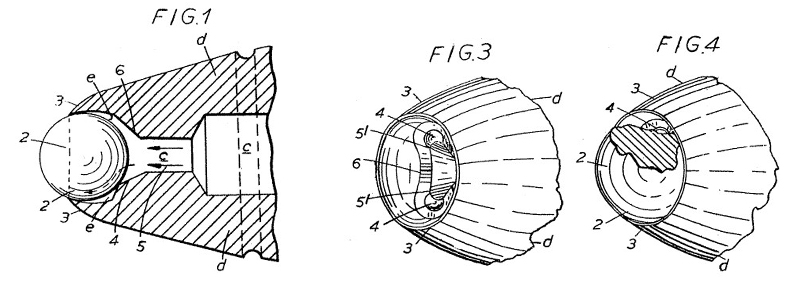
DE912309B
The man with the pen
He invented one of the most produced devices in history, but hardly profited from it: László Bíró is the father of the modern ballpoint pen, which still bears his name in many countries today.
The creative jack-of-all-trades was born László József Schweiger in Budapest on 29 September 1899. His father, Mózes Mátyás, was a Jewish dentist who "hungarianised" the family name to Bíró in 1905 in order to promote the family's assimilation.
Bíró was a man of many talents. He studied medicine until he discovered hypnosis. He dropped out of university and worked as a hypnotist with some success. By his own account, he was also at times a racing driver, graphologist, biologist, insurance agent, lorry driver, painter, author and sculptor. And, of course, an inventor - he is said to have been involved in the development of an automatic gearbox for cars, for example. Whether all of this is true is almost impossible to verify today. What is certain is that he was working as the editor of a cultural magazine when he had the idea for his most important invention.
Playing children inspired him
It is said that Bíró was watching children playing with marbles when he noticed how one ball rolled through a puddle and then left a trail on the dry ground. Could this be the revolution in writing? Ink running over a ball? Back then, fountain pens tended to blot and smear, pencils were fragile and only wrote in grey - so there was a need for action...
Of course, this idea was not entirely new. Galileo Galilei is said to have sketched a kind of ballpoint pen, but this might be just a myth. In 1888, John J. Loud applied for a ballpoint pen patent in the USA ( ![]() US392046A). Loud was a trained lawyer, but worked mainly as a tanner. His pen was excellent for marking leather, but was too coarse for paper. As a result, it never came onto the market as a writing instrument. A few years earlier, Alonzo Townsend Cross is said to have developed a ballpoiint pen, but there are no patent records prove it.
US392046A). Loud was a trained lawyer, but worked mainly as a tanner. His pen was excellent for marking leather, but was too coarse for paper. As a result, it never came onto the market as a writing instrument. A few years earlier, Alonzo Townsend Cross is said to have developed a ballpoiint pen, but there are no patent records prove it.
The tough quest to find the right ink
Bíró was to spend many years working on his new writing instrument. The ink turned out to be the biggest problem in the development of the pens: it had to be neither too liquid nor too viscous, otherwise it would either dry too slowly on the paper or too quickly - namely already in the refill inside the pen.
Together with his brother György, a chemist, and a small team, Bíró developed an ink that had exactly the right consistency. In 1931, he presented his first "Go-Pen" at a trade fair in Budapest, but it was not until 1938 that he applied for patents in several countries (including the ![]() GB498997A,
GB498997A, ![]() CH204880A).
CH204880A).
At the time, Hungary was ruled by the Horthy regime, which was allied with Nazi Germany and also pursued an anti-Semitic policy. On 31 December 1938, the last day before a law came into force that made it illegal to take patents abroad, Bíró left Hungary with his family and went to France.
Escape to Argentina
But he couldn't stay there for long either, as German troops occupied the country in 1940. By a lucky coincidence, Bíró had met Argentinian President Agustín Pedro Justo a few years earlier. He now fled to his country.
In Argentina, the Bíró brothers were able to continue honing their ballpoint pens. Together with their friend Juan Jorge Meyne, they founded a company and called their pen "Birome" (a combination of their names). In 1943, László Bíró again applied for patents, also in the USA ( ![]() US2491082A). This was a milestone in the history of the biros, but it would still be a while before it became a mass product.
US2491082A). This was a milestone in the history of the biros, but it would still be a while before it became a mass product.
In the USA, a company called "Eversharp" acquired the licence to manufacture ballpoint pens based on Bíró's patent. But there were apparently still quality problems, so the pen was not a hit at first.
The Royal Air Force helps the biros to fame
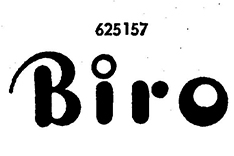
DE trade mark 625157
According to legend, the pen's use in the war was an important milestone. British businessman Henry George Martin sold Bíró's ballpoint pens on a large scale to the Royal Air Force. At that time, aeroplane navigators still worked with maps and pens, but fountain pens failed and regularly blotted at high altitudes. The biros, on the other hand, also worked excellently in the air. The Air Force is said to have ordered 30,000 of them in 1943.
A Chicago businessman named Milton Reynolds, who had got to know Bíró's pen in Argentina, brazenly circumvented Eversharp's licence rights and launched his own ballpoint pen called "Reynold's Rocket" on the market. He sold it in New York at the then hefty price of around 10 dollars - the daily wage of a labourer. Initially, thousands of pens were sold, but because they worked badly, sales soon collapsed and the price plummeted. The first pens that came onto the market in Germany in 1950 were also expensive: they cost around 20 marks.
Baron Bich makes a billion-dollar business
The real breakthrough came with the French Baron Marcel Bich. Unlike many other manufacturers, he duly obtained a licence (from the Swiss-based rights marketer Biro Patents) and made significant improvements to Bíró's pen (see e.g. ![]() US204527S). Bich founded the company BIC and launched the "Cristal" in 1950. The pen had a high-quality steel ball as a writing ball, but was otherwise made of inexpensive material. Its timeless design (transparent plastic so that the refill level can be read; coloured protective cap) made the "Cristal" a modern classic that is still in production today. With over 100 billion units sold, it is one of the best-selling products in history and has even made it into the collection of New York's Museum of Modern Art.
US204527S). Bich founded the company BIC and launched the "Cristal" in 1950. The pen had a high-quality steel ball as a writing ball, but was otherwise made of inexpensive material. Its timeless design (transparent plastic so that the refill level can be read; coloured protective cap) made the "Cristal" a modern classic that is still in production today. With over 100 billion units sold, it is one of the best-selling products in history and has even made it into the collection of New York's Museum of Modern Art.
The ballpoint pen´s triumphal march began with the affordable, reliable "Cristal". By the mid-1950s, around one billion pens were already in circulation around the world. The pens wer big business idneed!
Bíró wasn´t the one to get rich
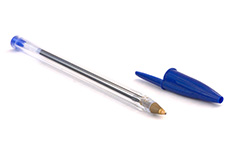
The world´s best selling ballpoiint pen since 1950: BIC Cristal
Laszlo Bíró hardly profited from this, however. He had sold the patent rights (it is unclear who exactly bought them from him. Sometimes Eversharp is mentioned as the buyer, then Martin again; also BIC, but they probably only acquired a licence). In any case, many ballpoint pens were put on the market by companies that cared little about the rights. Marcel Bich, however, whose company later enjoyed great success with its lighters and disposable razors, became really rich indeed.
László Bíró, who continued to apply for patents (including ![]() DE912309B), , is reported to have said later: "I often think that with a little more business acumen I could have made a huge fortune with my invention, but I harbour no grudges. The biros has become the most popular writing instrument in the world, it has overtaken the pencil and fountain pen, and that thought makes me forget the riches I missed out on."
DE912309B), , is reported to have said later: "I often think that with a little more business acumen I could have made a huge fortune with my invention, but I harbour no grudges. The biros has become the most popular writing instrument in the world, it has overtaken the pencil and fountain pen, and that thought makes me forget the riches I missed out on."
His Name liveth on
Bíró continued to be creative as a senior employee at pen manufacturer Sylvapen. He transferred the principle of the biros to perfume and became the inventor of the deodorant rollerball. However, mass production did not succeed at the time, so the idea only became established later - and Bíró did not profit from it – once again.
The subject of perfume never left him; he developed several fine fragrances. He also worked on a blood pressure and temperature measuring device for the wrist - another idea whose triumphal march would not begin until much later (in the form of current smartwatches). Biro, who died on 24 October 1985, also invented a new plastic, which he called "Birolit", and much more besides.
Although the biros did not make Bíró rich, his fame remained. In most English-speaking countries, in Italy and other nations, the ballpoint pen is called "biro" to this day. In Argentina it is called "birome", in France "biron". In Hungary, it is called "Go-Pen", as its inventor intended. In Argentina, Bíró's birthday, 29 September, is celebrated as "Inventors' Day".
Text: Dr. Jan Björn Potthast; Pictures: DEPATISnet, Public domain via Wikimedia Commons, DPMAregister, Trounce CC by3 .0 via Wikimedia Commons
Last updated: 10 December 2025

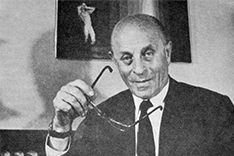
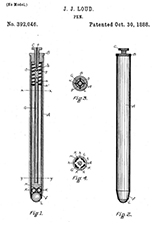

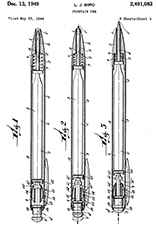
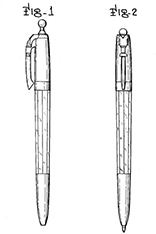
Not only protecting innovations
Social Media